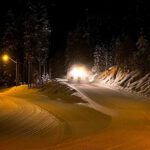Home »

Lady Orchid keeps our Canadian Lancaster aloft
By Elinor Florence
 There’s still one iconic Canadian Lancaster bomber in the air, flying out of Hamilton, Ontario – and the man indirectly responsible for the rebirth of the old aircraft was former Lancaster pilot Ron Jenkins. His daughter Deb Nichol (right), who lives in Windermere, explains the fascinating chain of events.
There’s still one iconic Canadian Lancaster bomber in the air, flying out of Hamilton, Ontario – and the man indirectly responsible for the rebirth of the old aircraft was former Lancaster pilot Ron Jenkins. His daughter Deb Nichol (right), who lives in Windermere, explains the fascinating chain of events.
The Canadian Lancaster FM-213, nicknamed Vera because of its V-RA markings, drew worldwide attention last summer when it flew across the Atlantic to England, to rejoin the only other flying Lancaster in existence. Above is a photo of Vera in flight.
Few people know that Vera’s ability to fly today is linked to a former Bomber Command pilot, whose daughter lives right here in the East Kootenay.
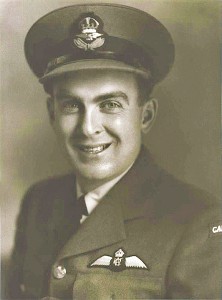 Deb Nichol and her husband Ross escaped from Calgary and moved to the mountains several years ago. Both of her parents served in the RCAF. Her mother Jeannie Jenkins was a “Sparks” working in Communications. But it is her father’s name, Ron Jenkins, that is better known in aviation circles.
Deb Nichol and her husband Ross escaped from Calgary and moved to the mountains several years ago. Both of her parents served in the RCAF. Her mother Jeannie Jenkins was a “Sparks” working in Communications. But it is her father’s name, Ron Jenkins, that is better known in aviation circles.
Ronald Henry Jenkins was born on July 8, 1913. His father owned a successful grocery store, which burgeoned into a chain of stores around southern Alberta, and Ron eventually joined the family business.
At the age of 29, Ron enlisted in the Royal Canadian Air Force, graduated as a pilot and was posted overseas where he flew with the 434 Squadron, the Bluenose Squadron out of Yorkshire.
Ron flew a total of 15 operations, the last five in a brand new Lancaster with the code WL-O. At first the crew named her “Wee Lady Orchid” for the code letters W-LO. Later they dropped the Wee and she became Lady Orchid.
Pilot Ron Jenkins painted the name in large white letters with a larger red capital L and O. The complete crew then shared in the painting of the naked girl riding a bomb while holding two western-style six shooters – due to the Wild West connection of their Calgary pilot.
Ron also painted 15 white bombs for 15 completed missions, and one red bomb for an aborted operation. Here’s a photograph of the original nose art, showing a topless Lady Orchid.
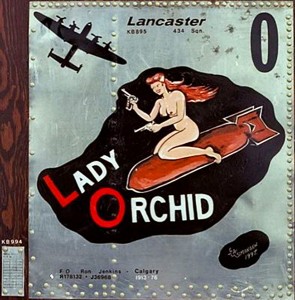 In May 1945 victory was declared in Europe and in June, the squadron left for the transatlantic flight home to Canada. For the sake of modesty (and no doubt imagining what their Canadian mothers would say), the crew painted two red maple leaves over Lady Orchid’s breasts.
In May 1945 victory was declared in Europe and in June, the squadron left for the transatlantic flight home to Canada. For the sake of modesty (and no doubt imagining what their Canadian mothers would say), the crew painted two red maple leaves over Lady Orchid’s breasts.
Ron flew Lady Orchid back to Canada himself, landing in Dartmouth, Nova Scotia. He then took the train home to Calgary.
Lady Orchid, along with hundreds of other Lancasters, was placed into long-term storage. It wasn’t until two years later that Ron learned that “his” aircraft was being ferried to Penhold, Alberta.
His daughter Deb provided the following transcript of a 1975 interview. Here’s how it happened, in his words.
*****
Two years after the war, I learned from a friend that the aircraft I had flown back was being ferried up to Penhold where there was a big station. Of course they knew it was mine, because it had Ron Jenkins painted on the fuselage.
So I went down to see a gentleman who at that time was head of the Crown Assets Disposal Corporation. And I explained that there was one particular aircraft that was up at Penhold, and it was “my aircraft,” as I termed it. I was the only pilot that ever flew that aircraft other than bringing it out from Dartmouth to Penhold on the ferry mission. If it ultimately came up for sale, I would like to know what happened to it.
Somehow or other it captured his imagination and he said: “That would make a very good human interest story. A pilot buys his own aircraft.” And I said, “Yes, but goodness gracious, I can’t afford to buy a Lancaster aircraft. There are four Rolls Royce Merlin engines on it, and the aircraft would have a value, without any armament, without any navigational equipment, without any radar, any of those flying auxiliary features which the air force put in, of about $500,000!”
“Well,” he said, “Let me see what I can do.”
About two months later, he phoned me and asked me if I would come into his office. So I went down and he said: “I’ve got some good news for you, Jenkins. I think I can sell you this aircraft that you wanted.”
I said: “Goodness, gracious, the price you will want for it will be so prohibitive, I didn’t want to buy it, I just wanted to know what happened to it!”
He said: “We must put two conditions on the sale of the aircraft. First – you will never ask for a Certificate of Airworthiness. In other words, you are not to apply to the Minister of Transport for permission to fly the aircraft. Secondly, you must sell us two of the engines. One we want for SAIT (Southern Alberta Institute of Technology in Calgary) for an aeronautical course there, and one for NAIT (Northern Alberta Institute of Technology in Edmonton.) We will buy these two engines. We will take the two engines out.”
So then I said: “What are you going to charge me for the aircraft?”
Much to my surprise, he said: “We are going to charge you $300 for the aircraft and will buy each of the engines back for $100 apiece.”
I ended up buying, to my knowledge, the first aircraft the Crown Asset Disposal Corporation ever sold after the war. They might have sold some smaller aircraft, but this was the first Lancaster that they sold and the first of the bigger planes. I bought my aircraft, Wee Lady Orchid. I gave him a certified cheque for $300 and in time, I received a cheque from SAIT for $100, and a cheque from NAIT for $100.
Then the problem was: how do I dispose of the aircraft? I had to get it off the Penhold airfield within a 90-day period. The wingspan of a Lancaster is 102 feet and of course it was too wide to take down a highway. So it did present a bit of a challenge. How I got around it, was I had a real estate friend in Red Deer search the title to all the property that abutted onto the airport, and I found a chap by the name of Clifford Sloan who had a farm there and was interested in aviation.
I went to see Mr. Sloan and asked if he would like an aircraft for free. When I explained the story, he said: “If that’s the only problem, I can just cut my fence and with a tractor we’ll bulldoze the aircraft through the barbed wire fence which was cut, and we’ll pull it onto my property.”
The aircraft is still sitting there today. It is in very poor shape now, because I took mementos out for most of the crew. For example, for my navigator I took out his flight control instruments, and for my rear gunner, a fellow by the name of Bruce Baird of Olds, I took out the rear turret. I had people take them out on my account and then I shipped these parts to every one of my crew who by now were scattered all across Canada. I kept the flying control panel and the pilot’s seat.”
*****
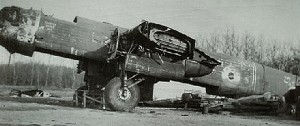
Meanwhile, back in Greenwood, Nova Scotia, several Lancasters were being modified for post-war service in the RCAF. One of them, the Lancaster FM-213, crash-landed and was damaged.
The Lanc could be repaired, but only if it had a new centre section. According to RCAF records, none existed in Canada. Then someone recalled the farmer in Penhold, Alberta, and his plans to build a shed from the discarded Lancaster.
 A phone call was made and the farmer was willing to sell Lady Orchid. The largest railway flat-car in Canada was sent from New Brunswick to Penhold in order to carry the centre section to Downsview, Ontario. It was loaded onto a flatbed truck and trucked to Penhold and put on a train east.
A phone call was made and the farmer was willing to sell Lady Orchid. The largest railway flat-car in Canada was sent from New Brunswick to Penhold in order to carry the centre section to Downsview, Ontario. It was loaded onto a flatbed truck and trucked to Penhold and put on a train east.
In July 1953, Lady Orchid’s centre section was transplanted into FM-213 Vera, and the rest is history. Today she is known as the Mynarski Lancaster, or Vera.
She is one of only two flying Lancasters remaining of the 7,377 built during the Second World War. And we owe it all to Lady Orchid.
But that wasn’t the only contribution that Ron Jenkins made to the Lancaster community.
Here he continues his 1975 interview, talking about yet another Lancaster:
*****
“A number of years later, some of us discovered that the Lancaster aircraft that hadn’t been sold or scrapped or cannibalized, which somebody would buy just to use up the spare parts, and use them by taking parts out of a good aircraft, to keep other aircraft flying. We found that there was one down in Fort McLeod. We had to pay $700 for that aircraft, and we arranged to have the aircraft flown from Fort MacLeod to Calgary. We arranged with a number of friends to contribute certain items which we required to mount that aircraft at McCall Field. That’s the aircraft that still stands on a pedestal at McCall Field.
“It had no romantic history, it was never on a dam busting raid, or as far as we could see by checking the log books, that it was just routine type of service during the war. But I can’t help reflect every time I drive by that aircraft on the way to the airport, because I do a lot of travelling and I have occasion to go to the airport many times. It brings back a lot of fond memories of Lancaster aircraft and my flying days in the air force.
*****
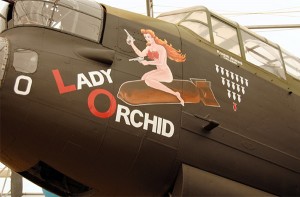 The FM-136 was mounted on a pedestal at the southwest entrance to the Calgary Airport terminal in 1962. Thirty years later, it was moved to the current museum site. The City of Calgary now owns the aircraft. It was restored by the Aero Space Museum and in 2011, it was dedicated to Ronnie Jenkins. In his honour, the nose art of Lady Orchid was recreated on the FM-136.
The FM-136 was mounted on a pedestal at the southwest entrance to the Calgary Airport terminal in 1962. Thirty years later, it was moved to the current museum site. The City of Calgary now owns the aircraft. It was restored by the Aero Space Museum and in 2011, it was dedicated to Ronnie Jenkins. In his honour, the nose art of Lady Orchid was recreated on the FM-136.
The family donated Ron’s uniform and some other mementos including his pilot’s seat, which is on display at the Aero Space Museum. One of Deb’s fondest memories is playing on that seat. “It sat down in the basement, and we would go down there and put Dad’s flying helmet on, and sit in the seat and pretend we were flying the Lancaster. Just seeing it today brings back some powerful memories.”
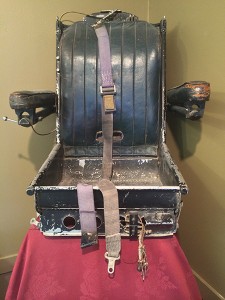 Ron Jenkins is remembered in yet another museum, the Bomber Command Museum in Nanton, Alberta. The museum there felt that Ron’s service was so important that they also have a replica of the Lady Orchid nose art on display, along with 56 other examples of aircraft nose art.
Ron Jenkins is remembered in yet another museum, the Bomber Command Museum in Nanton, Alberta. The museum there felt that Ron’s service was so important that they also have a replica of the Lady Orchid nose art on display, along with 56 other examples of aircraft nose art.
To read more, click: Bomber Command Museum Nose Art.
When Ron arrived home in 1945, he stepped into his new role as president and general manager of the grocery company. His father died two months before the war ended, and his mother died six months later. His only sister had also died at a young age.
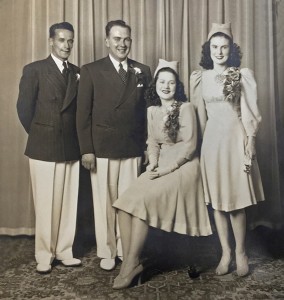 But he came home to his lovely wife Jeannie Campbell, whom he had married during the war. Here’s a wedding photo – the men are dashing in white pants, and the women stylish in the fashionable “kitten-ear” caps.
But he came home to his lovely wife Jeannie Campbell, whom he had married during the war. Here’s a wedding photo – the men are dashing in white pants, and the women stylish in the fashionable “kitten-ear” caps.
Ron Jenkins was one of the few fathers of that era willing to tackle full-time parental responsibilities.
He was awarded custody of the three children, and his wife moved away to Victoria. He hired a nanny to help care for the babies.
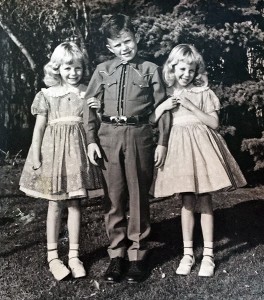 To the left is a childhood photo of the three kids, Jimmy in his cowboy shirt and his two adoring little sisters.
To the left is a childhood photo of the three kids, Jimmy in his cowboy shirt and his two adoring little sisters.
Under Ron’s guidance, the family grocery business became the dominant force in Calgary’s retail food industry. In 1959 Ron sold the business to Western Grocers, which entered a new stage of expansion under his direction.
Throughout the post-war years Ron also played a leading role with community service organizations such as the famed Calgary Stampede, United Fund, Chamber of Commerce, and the Rotary Club until his untimely death in 1976.
Today his son Jimmy Jenkins lives in Calgary, and both daughters – Deb Nichol and Dixie Jorginson – live in Windermere.
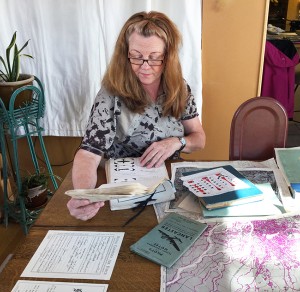 According to Deb, “Daddy” was the most wonderful father in the world. She was only twenty-one years old when her father died of prostate cancer on April 30, 1976, at the age of 64 — an event that devastated the family. “He was my father, mother, best friend and mentor,” she said. This photo shows her poring over her father’s extensive memorabilia.
According to Deb, “Daddy” was the most wonderful father in the world. She was only twenty-one years old when her father died of prostate cancer on April 30, 1976, at the age of 64 — an event that devastated the family. “He was my father, mother, best friend and mentor,” she said. This photo shows her poring over her father’s extensive memorabilia.
“What I will always remember about my father was his warmth and his kindness,” said Deb. “He was a true humanitarian, and he taught all his children the importance of giving back to the community. Even more important than his war record was his lifelong service to his family and to his community. That’s how I would like him to be remembered.”
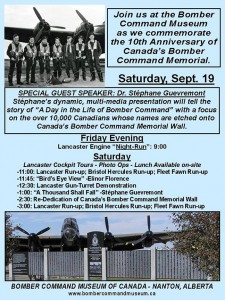
Thank you, Ron Jenkins, for your service to your country during World War Two, and for the immense effort you made to ensure that two of our prized Lancasters – Vera in Hamilton, and Lady Orchid in Calgary – remain in existence as a public reminder of their role in the Allied victory.
Note to Readers: If you would like to see a copy of Lady Orchid’s nose art, and see with your own eyes a Lancaster with all four engines running, visit the Bomber Command Museum in Nanton, Alberta, on September 19. I’ll be speaking there about my book Bird’s Eye View, and there are many other events taking place. Here’s the complete schedule.
© Story and Photos by Elinor Florence
 – Career journalist Elinor Florence, who now lives in Invermere, has written for daily newspapers and magazines including Reader’s Digest. She writes a regular blog called Wartime Wednesdays, in which she tells true stories of Canadians during World War Two. Married with three grown daughters, her passions are village life, Canadian history, antiques, and old houses. You may read more about Elinor on her website at www.elinorflorence.com.
– Career journalist Elinor Florence, who now lives in Invermere, has written for daily newspapers and magazines including Reader’s Digest. She writes a regular blog called Wartime Wednesdays, in which she tells true stories of Canadians during World War Two. Married with three grown daughters, her passions are village life, Canadian history, antiques, and old houses. You may read more about Elinor on her website at www.elinorflorence.com.
 Elinor’s first historical novel was recently published by Dundurn Press in Toronto. Bird’s Eye View is the only novel ever written in which the protagonist is a Canadian woman in uniform during World War Two. The heroine Rose Jolliffe is an idealistic Saskatchewan farm girl who joins the Royal Canadian Air Force and becomes an interpreter of aerial photographs. She spies on the enemy from the sky and makes several crucial discoveries. Lonely and homesick, she maintains contact with Canada through letters from the home front. The book is available through any bookstore including Lotus Books in Cranbrook, and also as an ebook from any digital book provider including Amazon, Kindle and Kobo. You can read more about the book by visiting Elinor’s website at www.elinorflorence.com/birdseyeview
Elinor’s first historical novel was recently published by Dundurn Press in Toronto. Bird’s Eye View is the only novel ever written in which the protagonist is a Canadian woman in uniform during World War Two. The heroine Rose Jolliffe is an idealistic Saskatchewan farm girl who joins the Royal Canadian Air Force and becomes an interpreter of aerial photographs. She spies on the enemy from the sky and makes several crucial discoveries. Lonely and homesick, she maintains contact with Canada through letters from the home front. The book is available through any bookstore including Lotus Books in Cranbrook, and also as an ebook from any digital book provider including Amazon, Kindle and Kobo. You can read more about the book by visiting Elinor’s website at www.elinorflorence.com/birdseyeview







